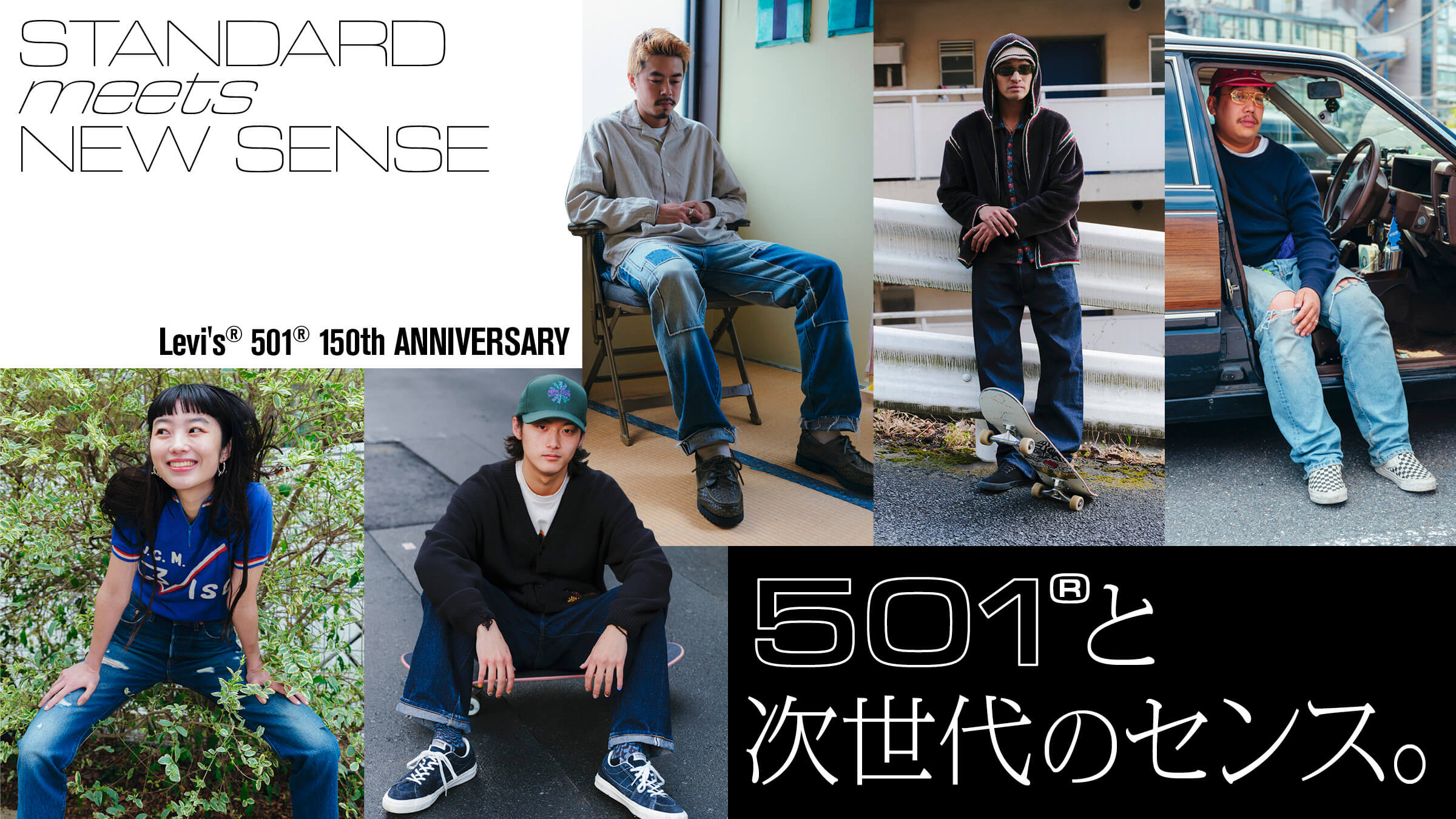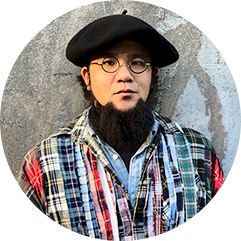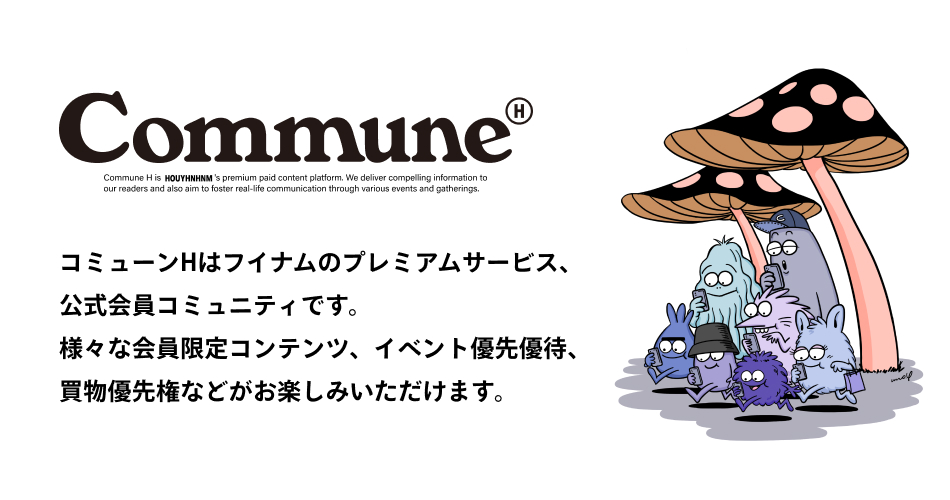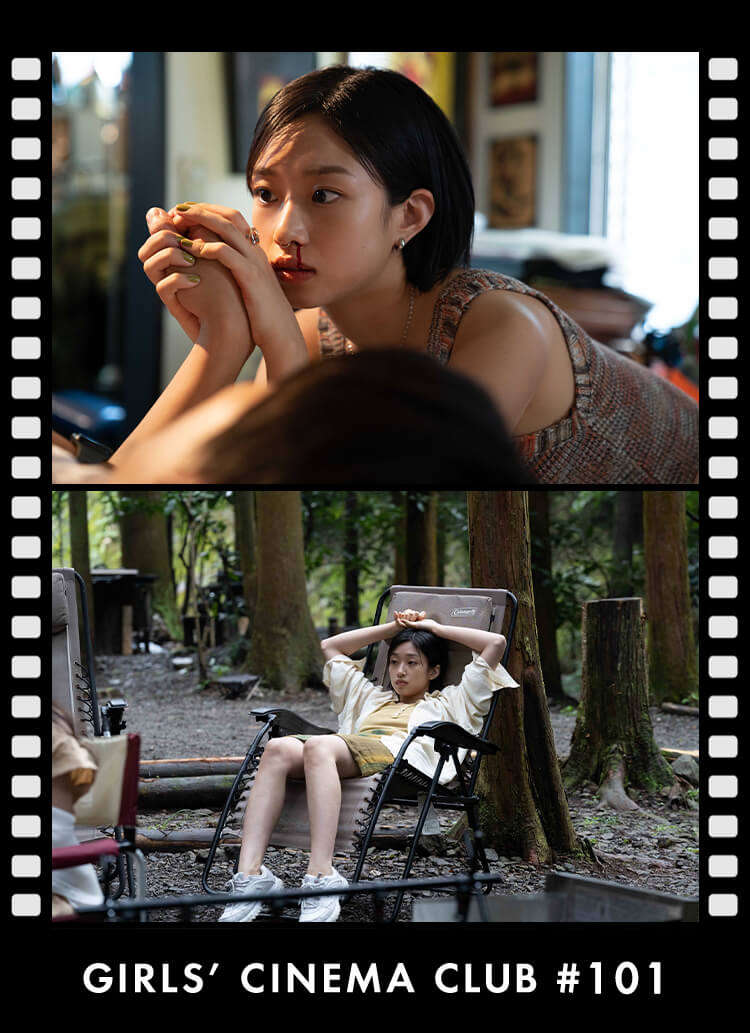



-
 Taichi Watanabe
Taichi Watanabe -
 Maoho Aikawa
Maoho Aikawa -
 Kaito Sagawa & Joshua Nishinomiya
Kaito Sagawa & Joshua Nishinomiya -
 UDAI
UDAI
Taichi Watanabe x Levi's® Made & Crafted® LMC 80's 501® I want to keep my pictures for a long time, too, so I think I have a lot to learn from the 501®.
PROFILE
Born in Tokyo , Japan in 1997. While working at the print and design studio "PAJA STUDIO," he is also a student at the Graduate School of Oil Painting I of Tokyo University of the Arts. In July 2009, he held a solo exhibition of his prints, "Footprints," at BEAMS T. He is currently working on an oil painting exhibition based on the concept of "movable windows. Currently, he is working on oil paintings based on the concept of "movable windows.
Instagram: @1899_tw



I heard that your grandmother used to live in this studio.
Watanabe:. yes, I am. School was out for spring break, and I was looking for a place to paint. I thought I hadn't used this house for a while, so I talked to my grandfather about it, and he said, "It's fine. He said, "It's fine," and I felt very comfortable. I have been here for a long time, so the atmosphere of the town is familiar to me.
The concept of the work you are creating is "movable windows," isn't it?
Watanabe:Simply put, it is like a door to anywhere (laughs). Ordinary windows cannot be moved and the view is fixed, but once they are painted, you can control what you see beyond them and still be able to move them.
. When I looked at your work, I wondered if you dared to paint in an abstract manner.
Watanabe:I haven't titled my work for a long time. I can't think of a title that fits the scenery, and I don't want to limit what I can see by giving it a title.
. The more abstract the work becomes, the more difficult it is to see it through to completion, isn't it?
Watanabe:When I entered the school, my professor told me, "You don't know anything yet. However, after spending the past year working on my own artwork, I feel that I am gradually gaining a better understanding of what painting is all about. Recently, I have become able to sense when it is time to stop.


Compared to yourself a year ago, do you feel any different?
Watanabe:. the thickness is different. It is a repetition of updates. There was a time when I used to compare myself with others by being somewhat cool, or by worrying only about my title, but that is no longer the case. It may be obvious, but now I think such things are meaningless, and it is a battle against myself. Thanks to this, I am able to face various people and events with a broader perspective.
In that sense, fashion has become more relaxed in a good way. I don't care as much as I used to, or rather, I am no longer particular about genres and such.
Do you wear denim often?
Watanabe:I have quite a lot of jeans. I don't own jeans, but my favorite denim jacket is a Levi's® item. I bought it at a thrift store when I went to England, and my sister recommended it to me. It holds a special place in my heart, and I can't let go of it. I also have one pair of "501®" jeans that I bought at a thrift store.
The "501®" you are wearing this time has a unique design that makes use of the repair scars.
Watanabe:There is an artist named Pete Mondrian, whose style I somehow linked to mine. I happened to find these when I went to the Levi's® Store. I thought it was very intricate, and I thought that this was the kind of denim I would like to wear.
The size is just right.
Watanabe:At 34 inches, the waist is a little loose , but the slimness is just right. This kind of fit, not too thick and not too thin, is very mature. I like leather shoes, so it is easy to match with such shoes.
The hem is folded back to provide a cushion.
Watanabe:. I kind of like the way it looks now. But if I get tired of it, I may hem it. That's just how I feel.



In the past, the idea that denim is something to be grown was so prevalent that many people were particular about not picking up items with a high level of design or processing. In the case of Mr. Watanabe, it seems that there are no such stereotypes.
Watanabe:Yes, that's right. It is no use looking at only one aspect. I don't think I fit in with this kind of unspoken understanding, such as "I only wear this brand because it's street fashion. There are many cool things if you look at it differently, so I want to have contact with various things from a broader perspective.
This year marks the 150th anniversary of the "501®" brand.
Watanabe:I want my drawings to last for a long time, so I guess I have a lot to learn from "501®". I have heard that the shape of "501®" is changed little by little according to the times, and I was convinced that this is why the "501®" seen in thrift stores look different from each other. I want my paintings to be the same way. The core of my work remains the same, but I want it to change. I think that there are good reasons for things to last for a long time, and I think that Levi's® was able to survive because it was flexible enough to change in this way. I think "Levi's®" is amazing.
The 1980s 501® Jean by Levi's® Made & Crafted® , based on an archival design loved by musicians, celebrities, and other style icons. . The selvedge denim is made from the highest quality organic cotton, and is tailored for a loose, gender-free fit.
Maho Aikawa × Levi's® 501® JEANS FOR WOMEN Denim is interesting in that it shows the character of the person who wears it.
PROFILE
Born in 1999 in Kanagawa , Japan. After working as an idol, she entered an art college and majored in photography. In October 2020, she resumed her career as a model, and has been active in advertising, magazines, websites, radio, and many other media.
Instagram: @mahoaikawa3



Two years have passed since you started your career as a model, and how do you feel about your work now?
Aikawa:Before joining a modeling agency, I had a part-time job in the editorial department of GIRL HOUYHNHNM. The experience I gained working behind the scenes there has been very useful in my current job, and I think it has broadened my horizons. I really enjoyed it.
What do you enjoy most?
Aikawa:After all, I love fashion, and I chose modeling as a career that involves clothes, so I am simply happy and enjoy being surrounded by a lot of clothes.
. It was your mother that made you fall in love with fashion in the first place, wasn't it?
Aikawa:Yes, that's right. My mother worked in the fashion industry when I was young, and I grew to like it as I was exposed to various kinds of clothes. I became friends with my mother's friends from a young age, and I found myself hanging out with them without my mother. That is how I was inspired and inspired by the adult world.
Do you find that your mood changes when you wear different kinds of clothes?
Aikawa:. To tell the truth, I am not very confident about myself. But by wearing clothes, I finally feel confident, and my mood is lifted.




Do you usually wear denim?
Aikawa:To be honest, I have never worn jeans before. When I go out, I like to dress neatly and comfortably, as if to put myself in the right frame of mind. . That's why it was so refreshing to be allowed to wear "501®" jeans this time. Before the shoot, I went to my mother's room and pulled out a vintage "501®" and put it on, and it was the perfect size. I had never touched this item before, but when I looked at my outfit in front of the mirror, I thought, "I look good! I begged my mother to give it to me (laughs).
It is also a unique feature of "501®" to be able to pass it on in this way.
Aikawa:I think denim is interesting because it shows the character of the person who wears it.
You are wearing a damaged model this time, why did you choose it?
Aikawa:I went to the store and picked one out, and was surprised to see how many different kinds of 501® there are (laughs). I was surprised at first (laughs). (Laughs.) My mother's 501®s were simple, so I thought they were the only kind of items available. However, there were also some very well-designed models, and I was looking at all kinds of things. . After much deliberation, I chose this item as one that was simple but had a little design in it. . I wanted something that was not too understated, not too assertive. . I also chose a slightly slimmer size so that it wouldn't look sloppy (laughs).


The blue knit and the coordination match the color of the denim very well.
Aikawa:. I bought this secondhand clothing when I was in high school, but I've only worn it once. I picked it up because I thought the cycling design was interesting, but I never got a chance to wear it, so I thought it would be a good item to wear with my 501®. . Even items that I never wore can be revived by pairing them with denim.

The fact that the "501®" item has always been universal may be the reason why it is easy to match it with many outfits, including vintage clothing.
Aikawa:When I hear the name "Levi's®," denim and "501®" come to mind, and I think that they are items that have penetrated the world. I am also very moved to think that in its 150-year history, it has been worn and loved by so many people. Having the opportunity to wear them this time, I realized that they also go well with beautiful clothes, and I would like to grow my own "501®" as a vintage item in the future.
The classic straight leg of the 501®, with a strong wash from the thigh to the knee that beautifully accentuates the lines of the leg. This model was made to commemorate the 150th anniversary, and the "150" is engraved on the patches, red tabs, and the backs of the rivets, giving it a subtle sense of fun.
Kaito Sagawa x Levi's® Vintage Clothing 1955 501® RINSE
Joshua Nishimiya x 501® ORIGINAL CRYSPY RINSE
Levi's® is a cool brand with absolute value.
PROFILE
Born in Tokyo , Japan in 1998. He started skateboarding in the first grade of elementary school at the suggestion of his father, a surfing instructor. After that, he performed well in various competitions and signed sponsorship contracts with many brands. Currently, he is active on the street.
Instagram: @kaito5agawa
PROFILE
Born in 2000 . A skateboarder with roots in Japan and Ghana. Sponsored by various brands, he is a member of the skate crew "Ferris Tokyo," to which Sagawa also belongs, and produced the skate video "MEADOWS" with "Levis®".
Instagram: @joshuanishimiya



What do you think is unique about each other's skating style?
Kaito:Joshua is very springy. There is a height to his technique, a dynamic quality, and so on.
Joshua:Kaito has a crazy great technique. He's pretty much an all-rounder.
Kaito:I'm good at detail. . because I want to skate in that terrain.
Do you feel that this has changed your skating style or awareness?
Joshua:The movements themselves have not changed much. I am not really conscious of that.
Kaito:. I had a domestic brand produce a pro deck with my name on it.
Joshua:Some people think that receiving sponsorship means you are a professional, but we think that once you have a professional model, you are a professional. Until such a model is released, there are not many people who call themselves professionals.
I see.
Kaito:When I used my own deck, I wanted to show it off, and on the other hand, when I saw people skating with it, I got excited and felt like I had to do my best.
Joshua:Yes, that's right. I don't have my own model, but when I see a sticker of a sponsored brand, it makes me feel better (laughs).




How did you get connected with Levi's®?
Joshua:I was approached by a skate media campaign called "VHSMAG. I said, "I'm from a big company! Oh my God! (laughs). (Laughs). The staff member in charge of the campaign was very cheerful and we became friends. At the time, there was no Levi's® skate team in Japan, so I suggested that we make a video, and they immediately agreed to do it.
Kaito:So we made a film last year and held a preview.
What kind of image do you have of the brand?
Joshua:A cool brand with absolute value.
Kaito:I have the impression that this is the origin of the brand. Levi's® was the first to make jeans.
Joshua:That's right. I tried making jeans for other brands, but in the end, I thought "Levi's®" was the coolest.





How do you think skates and "501®" go together?
Kaito:We want to be able to move around easily, and Joshua is especially tall and big, so a thicker silhouette is better for him. When I first tried on a pair of "501®" jeans, I thought they were a little thin. When I first tried on the 501®, I had the impression that they were a little thin. But when I tried wearing a new pair with a larger waist size, I found that they slipped on easily at all. There are many different models of 501®, and some of them have a thicker silhouette.
Joshua:Yes, it is. It's pretty easy to do.
Kaito:I used to wear chinos, but when I carried my skateboard with my phone in the side pocket, the deck tape would rub against them and make holes in my pants. But I've been wearing Levi's® denim for over a year now, and it doesn't look like that.
Joshua:I don't have one available either.
Kaito:The ones I'm wearing now will be one year old soon. I think it's nice to see them develop their own unique style.
Joshua:I'm glad we're connected to Levi's® and that we're part of, or rather contributing to, the 150-year history of the "501®". . The photos we took this time, as well as the skate video we shot the other day, will stay with us.
Kaito:I want to convey that coolness to all kinds of people. I am currently wearing a reissue of the 1955 model, and I think that this too has been passed down from the original. I want to preserve this culture and pass it on to the next generation.
Joshua:. I still want to tell skaters about it. As Kaito said, there may be an impression of slimness, but there are also "501®" that fit us well. I would like to continue to communicate this to skaters.
The classic straight silhouette of this iconic Levi's® model has been loved by people around the world as the ultimate jeans that bring out the individuality of the wearer since the lot number "501®" was given in 1890. A must-have item as a fashion staple.
This model represented the biker style of the 1950s, and introduced paper patches that imitated leather. It is a well-known anecdote that many delinquents of the time loved these jeans and were banned from wearing them in college. These are the thickest and most rugged jeans among the reissued models, and go well with skates.
UDAI x Levi's® Authorized Vintage 501® ORIGINAL The "501®" teaches us the importance of keeping going.
PROFILE
Born in Tokyo , Japan in 1994. Photographer and videographer belonging to YouthQuake, a crew that leads Japanese youth culture. He is active in a variety of fields regardless of the medium, shooting looks for fashion brands and music videos for musicians. On the other hand, he also produces his own zines and is actively involved in other activities.
Instagram: @udai65



When did you start shooting the video?
UDAI:I started about four years ago. After graduating from Bunka Fashion College, I did not get a job, but instead traveled around. However, I had a vague idea that I needed to start something on my own by the time I was about 25 years old. I had always been taking pictures with film, and many of my seniors around me were rappers, so I was often allowed to go to photo shoots. I was often allowed to go to photo shoots with a handheld camera. It was at that time that I met my mentor, who helped me learn the basics.
. In an age when many people suddenly start out as creators, you made an unusual choice.
UDAI:I am the type of person who learns by doing things myself. It suits me better. By working with a master, I am allowed to go to sites that I would not have been able to go to on my own. So it's a lot of fun. I get to experience a lot of different things.
You are from Fussa, aren't you?
UDAI:To put a finer point on it, it's next to Fussa. Almost Fussa . There is a U.S. military base in the U.S. , and it is an interesting place.
Is American culture strongly rooted in your work?
UDAI:. I like it. Ever since I was little, when I went to the supermarket in Fussa, I would see foreign people wearing sports brand sneakers and white socks, and I thought it was cool. I also happened to have a channel at home called Cartoon Network that aired American cartoons, and I used to watch them all the time. I watched "Tom and Jerry" and so on. When I think about my influences, cartoons were a huge part of my life.

Do you see a link between these influences and the work you are creating now?
UDAI:I think there is. I still have a VHS TV at home, and a friend of mine gave me a lot of VHS when he moved to New York a while ago. I used to watch movies on it. There were also skate videos, and I liked the atmosphere of the 90s, which is reflected in my work. I like the texture of the noise, the fish-eye lens, and the feeling of not having a predetermined shot in mind, but just going with the flow on the spot.
I think it is hard to express that kind of groove nowadays, isn't it? The equipment has been upgraded, and anything can be taken beautifully.
UDAI:Last year, I was having some of these problems. I felt that I needed to improve my skills and be able to shoot beautiful videos. I was thinking that I need to improve my skills and be able to shoot beautiful images. But there was a part of me that thought it looked somewhat fake. Even when shooting a hip-hop video, the distance between the director and the artist is very important, and I think it is something that is born from things like hanging out together or going out at night on the town. I value this and want to do things with a proper understanding of the culture.


UDAI-san, you have worked with "Levi's®" before, right?
UDAI:I was allowed to follow my mentor to the field. . there I made connections with the brand people.
I know you actually wear denim yourself, but what is your impression of the brand?
UDAI:Denim is so classic that when you think of denim, you think of " Levi's®. My father used to wear them when I was little, and when I was in junior high school, I wanted to buy a pair but couldn't, so I secretly wore his "501®" (laughs).



The "501®" you were wearing this time is vintage, isn't it?
UDAI:. Not only this denim, but I probably buy more used clothes than new ones. The "501®" I am wearing today is also soft and comfortable. I used to wear "550™" a lot, but since I got this denim, I've been wearing it all the time. I had the impression that "501®" didn't fit my body shape, but this one fits me perfectly, so I like it very much.
This year marks the 150th anniversary of the "501®" brand.
UDAI:I respect them very much. I am attracted to things with a long history rather than new things. I think it is very important to keep on creating, and it is amazing to see how they keep on improving while preserving what is important to them. When I meet professionals in various fields of film and video, I feel that skills are born from the fact that they continue to work without stopping. When I started my current job, I couldn't even edit or smoothly attach a lens, but I improved my skills by continuing. I feel that "501®" teaches us how difficult and important it is to keep going.
Levi's® Authorized Vintage" buys vintage clothing from the 1980s and 1990s, washes them so that they can be worn beautifully, and sells them. Levi's®'s sustainable approach, which combines environmental friendliness and business, is made possible because these items are universally designed with period durability.









